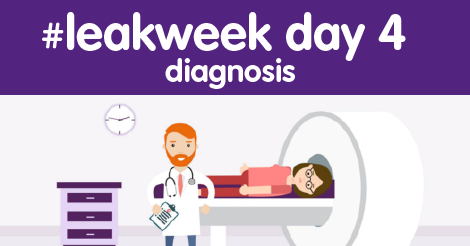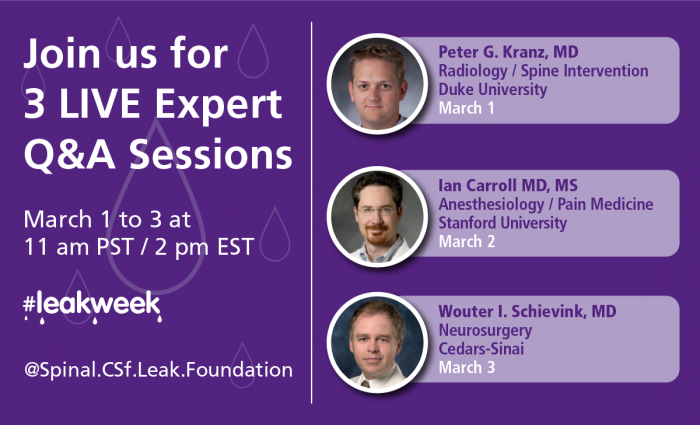Today is DAY 4 of Spinal CSF Leak Awareness Week.
Our focus for today is on: Diagnosis of spinal Cerebrospinal fluid (CSF) leak.
For the majority of patients with spinal CSF leak, the diagnosis is missed entirely or delayed by months or years. Because this is treatable and curable, a quicker and correct diagnosis is critical to reducing unnecessary suffering and disability.
Reasons that the diagnosis is missed or delayed:
• awareness by health care professionals remains low, as we see with all uncommon or uncommonly recognized disorders.
• the physical exam may be entirely normal
• imaging may be misinterpreted as negative or be in fact negative
It is important to understand that normal findings do not rule out a spinal CSF leak.
See this short video discussing the diagnosis of spinal CSF leak.
Patient History
The most important clues to the diagnosis of intracranial hypotension lie in the patient history.
The hallmark symptom of positional headache is the most important clue. We call this an “upright headache”. It is important to note, however, that not all headaches related to spinal CSF leaks are positional and not every patient with a positional headache has a spinal CSF leak. We covered the topic of symptoms on Day 2 of #leakweek. Common and uncommon associated symptoms are also listed on our Symptoms page.
Important aspects of the patient history that physicians need to consider are:
• Recent medical procedures such as lumbar puncture, epidural injections, epidural anesthesia and spinal surgery
• Recent trauma
• Known heritable disorders of connective tissue (HDCT) such as Ehler-Danlos syndrome and Marfan syndrome
• Known spinal problems such as degenerated discs or bone spurs
• Previous diagnosis of POTS (postural orthostatic tachycardia syndrome) which can mimic symptoms frm spinal CSF leak or coexist in the same patient
• Previous diagnosis of Chiari – Low-lying cerebellar tonsils on brain imaging can be the result of spinal CSF leak OR it may be congenital OR both. To complicate matters, congenital Chiari is also more common in patients with some types of HDCT.
Physical Findings
Physical findings may be entirely absent which adds to diagnostic confusion, but physicians may note:
• A patient with spinal CSF leak will often be lying flat for comfort
• Signs of heritable disorders of connective tissue disorders may be noted such as joint hypermobility, high arched palate, dental crowding, tall stature, scoliosis (curvature of the spine), easy bruising, abnormal scars and a number of others
• Abnormalities on detailed neurologic exam such as involvement of cranial nerves, cognitive changes, abnormal gait, tremor, signs of dementia, muscle weakness or changes in strength
• Emergency Medicine physicians may see patients with quadriplegia, stupor, coma or other serious neurologic presentations. Death is a reported complication, albeit rare.
Diagnostic Testing
Testing may include a lumbar puncture (spinal tap) to check for CSF pressure but is not required since this may be low, normal or even high in the presence of a leak.
Brain MRI should be done in all patients in whom the diagnosis is being considered. There are a number of findings remembers by the mnemonic SEEPS, however the brain MRI is normal in about 20% of cases so cannot rule out the diagnosis.
Spinal imaging is performed to locate a spinal CSF leak. A variety of spinal imaging techniques including CT, MRI and digital subtraction imaging are used to localize leaks. It should be emphasized that spinal imaging may not be necessary since many patients respond well to a procedure known as epidural blood patching. Unfortunately, spinal imaging will fail to demonstrate a spinal CSF leak in up to half of suspected cases which affects treatment options. More than one type of spinal imaging and/or repeat imaging is often necessary.
Lori’s Story
Watch Lori’s story of her spontaneous spinal CSF leaking related to her underlying Ehlers-Danlos Syndrome. She shares how her diagnosis was delayed until she found a neurologist who was familiar with spinal CSF leak. Read More Here of Lori’s experience.
If you have read this far, you may have a better understanding of the need for greater awareness and understanding of the diagnostic difficulties of spinal CSF leak by health care professionals.
For more information:
• visit our information page on Diagnosis and review our Diagnosis document.
• Learn more about some of the diagnostic challenges that physicians face in one of our most-viewed previous blog posts.
• Understand how the brain sinking down in intracranial hypotension can mimic Chiari malformation yet be reversible with treatment.
Visit our facebook page this evening to see photos of landmarks and buildings that will shine purple in honor of #leakweek.
Wells Fargo’s Duke Energy Center – Charlotte, NC
One Liberty Place – Philadelphia, PA
Two Liberty Place – Philadelphia, PA
Rundel Memorial Building – Rochester, NY
Barclay Damon Tower – Syracuse, NY
Building Owners and Managers Association (BOMA) of Chicago – Chicago, IL
King & Queen Buildings at Concourse – Atlanta, GA
Miami Tower – Miami, FL
Don’t miss today’s Expert LIVE Q & A session with Dr. Peter Kranz at 11 am PST / 2 pm EST on our facebook page and mark your schedule for the sessions tomorrow with Dr. Ian Carroll and Friday with Dr. Wouter Schievink.



